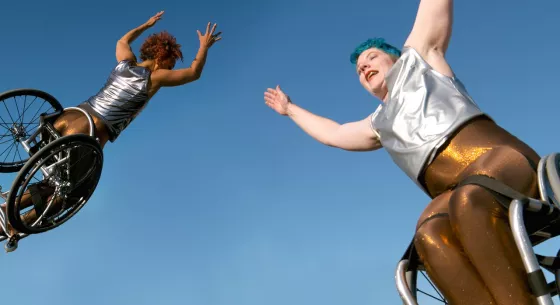Walker Art Center and Northrop are co-presenting Kinetic Light’s online film premiere version of DESCENT on Thu, Dec 3. We asked the company to describe the work. This is rachel hickman’s response:
If you can believe it, the mystical world of DESCENT emerged from an initial desire Michael Maag (Kinetic Light’s lighting designer) and Alice Sheppard (Kinetic Light’s artistic director) shared to create something in the shape of a spoon. By the time we premiered to audiences at BRITT Fest and New York Live Arts in 2017-2018, their creative inquiry had deepened beyond tableware—though the spoon’s influence lingers in the DESCENT Ramp’s curvature.
DESCENT is an immersive reclamation of queer, multiracial, disabled histories that challenges assumptions of femininity and beauty with unapologetic abandon.
Rolling her way through the Cantor Center for Visual Arts and the Stanford Rodin Sculpture Garden, Alice found herself thinking about Rodin and disability. She immediately began researching Auguste Rodin’s writings and sculptures and found herself caught by the Toilette of Venus and Andromeda. Rodin’s world forms the emotional and structural landscape of DESCENT with the Toilette as its anchor. Michael Maag bathes DESCENT in luscious light that highlights his renderings of the sculptures. On stage, Alice and Laurel Lawson wind their bodies into the forms of the 50 Rodin sculptures that are the movement vocabulary of the work. What does it feel like to become The Helmet Maker’s Formerly Beautiful Wife? The love story of Venus and Andromeda is cast across Michael’s deep sunset hues and vast starry nights. The dancers crawl and soar; the ramp and the light together are magic.
Kinetic Light is a disability arts ensemble; our work emerges from disability culture, history, politics, and aesthetics and we imagine disabled audiences as primary—always. We not only make art in the ways we move, but also in the ways we design. So, when Michael, Laurel, and Alice began working on DESCENT, they wanted to design a world that maximized the expression of wheeled movement and pleasure. Disability pleasure and movement joy are essential parts of the work. Laurel, along with Paul Schulte, designed sleek, streamlined wheelchairs that are works of art in themselves. And our Ramp, which arguably makes this duet a trio, is luxuriously sensual and desirable; its glowing landscape yearns to be explored. The Ramp was designed by Sara Hendren, Yevgeniya Zastavker, and students at Olin College in a class project that took on an incredible life of its own. Fingertips mere molecules apart, Laurel and Alice fly across its curved surfaces; this dance delivers a rush like no other.
Because we are accountable to our community, we are constantly learning more about crafting access and equitable aesthetic experiences. After one in-process showing, blind audience members told us that they couldn’t relate to certain moments that had taken other audience members’ breath away. We realized that the dance industry standard for audio description was unsatisfactory.
So we endeavored to make our audio description as intricate, human, and multi-layered as the visual content of the work. Integrating access into our work this way allows audiences to experience our work firsthand—regardless of the medium they’re using to engage with it.
You can find out a lot more about DESCENT, the Ramp, and Audimance (our app for audio description), but we would invite you to offer yourselves the gift of surprise. We want your experience of DESCENT to be just that: yours.
We did not plan to make this film, but 2020’s tumultuous times have given us the opportunity to ask ourselves different questions about performance. We dug into our archives and have been collaborating with fantastic editors and artists to transform the in-person DESCENT experience into an accessible, exciting online film. We couldn’t be more thrilled.
Welcome to DESCENT; welcome to our world.
rachel hickman is the creative co-conspirator for Kinetic Light.



